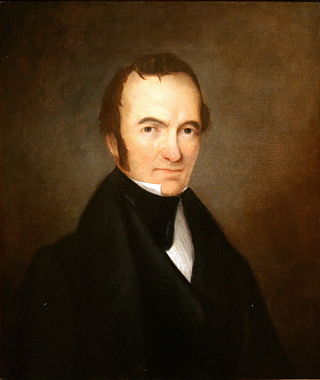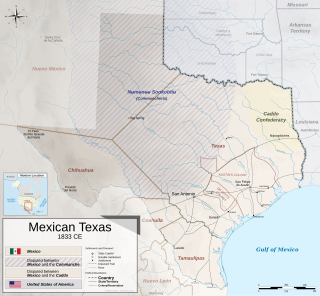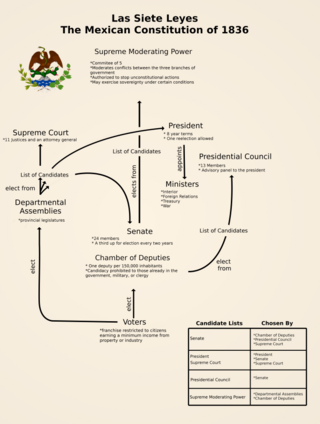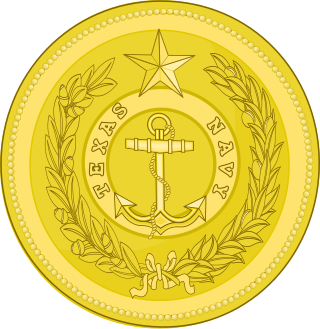
The Republic of Texas, or simply Texas, was a breakaway state in North America that existed from March 2, 1836, to February 19, 1846. It shared borders with Mexico, the Republic of the Rio Grande, and the United States of America.

The Texas Revolution was a rebellion of colonists from the United States and Tejanos against the centralist government of Mexico in the Mexican state of Coahuila y Tejas. Although the uprising was part of a larger one, the Mexican Federalist War, that included other provinces opposed to the regime of President Antonio López de Santa Anna, the Mexican government believed the United States had instigated the Texas insurrection with the goal of annexation. The Mexican Congress passed the Tornel Decree, declaring that any foreigners fighting against Mexican troops "will be deemed pirates and dealt with as such, being citizens of no nation presently at war with the Republic and fighting under no recognized flag". Only the province of Texas succeeded in breaking with Mexico, establishing the Republic of Texas. It was eventually annexed by the United States.

Stephen Fuller Austin was an American-born empresario. Known as the "Father of Texas" and the founder of Anglo Texas, he led the second and, ultimately, the successful colonization of the region by bringing 300 families and their slaves from the United States to the Tejas region of Mexico in 1825.

The flag of Texas is the official flag of the U.S. state of Texas. It is well known for its prominent single white star which gives the flag its commonly-used name: "Lone Star Flag". This lone star, in turn, gives rise to the state's nickname: "The Lone Star State". The flag, flown at homes and businesses statewide, is highly popular among Texans and is treated with a great degree of reverence and esteem within Texas. Along with the flag of Hawaii, it is one of two state flags to have previously served as a national flag of an independent country. In 2001, the North American Vexillological Association surveyed its members on the designs of the 72 U.S. state, territorial, and Canadian provincial flags and ranked the Texas flag second, behind New Mexico.

Washington-on-the-Brazos is an unincorporated community along the Brazos River in Washington County, Texas, United States. The town is best known for being the site of the Convention of 1836 and the signing of the Texas Declaration of Independence.

Mexican Texas is the historiographical name used to refer to the era of Texan history between 1821 and 1836, when it was part of Mexico. Mexico gained independence in 1821 after winning its war against Spain, which began in 1810. Initially, Mexican Texas operated similarly to Spanish Texas. Ratification of the 1824 Constitution of Mexico created a federal structure, and the province of Tejas was joined with the province of Coahuila to form the state of Coahuila y Tejas.
The Constitution of the Republic of Texas was the supreme law of Texas from 1836 to 1845.

An empresario was a person who had been granted the right to settle on land in exchange for recruiting and taking responsibility for settling the eastern areas of Coahuila y Tejas in the early nineteenth century. The word in Spanish for entrepreneur is emprendedor.

Las Siete Leyes (Spanish:[lasˈsjeteˈleʝes], or Seven Laws was a constitution that fundamentally altered the organizational structure of Mexico, away from the federal structure established by the Constitution of 1824, thus ending the First Mexican Republic and creating a unitary republic, the Centralist Republic of Mexico. Formalized under President Antonio López de Santa Anna on 15 December 1835, they were enacted in 1836. They were intended to centralize and strengthen the national government. The aim of the previous constitution was to create a political system that would emulate the success of the United States, but after a decade of political turmoil, economic stagnation, and threats and actual foreign invasion, conservatives concluded that a better path for Mexico was centralized power. The Siete Leyes were replaced in 1843, by the Bases Orgánicas.
- The 15 articles of the first law granted citizenship to those who could read Spanish and had an annual income of 100 pesos, except for male domestic workers, who did not have the right to vote, nor did women of any class.
- The second law allowed the President to close Congress and suppress the Supreme Court of Justice of the Nation. Military officers were not allowed to assume this office.
- The 58 articles of the third law established a bicameral Congress of Deputies and Senators, elected by governmental organs. Deputies had four-year terms; Senators were elected for six years.
- The 34 articles of the fourth law specified that the Supreme Court, the Senate of Mexico, and the Meeting of Ministers each nominate three candidates, and the lower house of the legislature would select from those nine candidates the President and Vice-president,
- The fifth law had an 11-member Supreme Court elected in the same manner as the President and vice-president.
- The 31 articles of the sixth Law replaced the federal republic's nominally-sovereign "states" with centralized "departments", fashioned after the French model, whose governors and legislators were designated by the President.
- The seventh law prohibited reverting to the pre-reform laws for six years.

The Texas Navy, officially the Navy of the Republic of Texas, also known as the Second Texas Navy, was the naval warfare branch of the Texas Military Forces during the Republic of Texas. It descended from the Texian Navy, which was established in November 1835 to fight for independence from Centralist Republic of Mexico in the Texas Revolution. The Texas Navy, Texas Army, and Texas Militia were officially established on September 5, 1836 in Article II of the Constitution of the Republic of Texas. The Texas Navy and Texas Army were merged with the United States Armed Forces on February 19, 1846 after the Republic of Texas became the 28th state of the United States.
Bryan v. Kennett, 113 U.S. 179 (1885), was a United States Supreme Court case in which the Court held that, under the treaty providing for the Louisiana Purchase, the United States would recognize property interests granted by the previous sovereign governments prior to the Purchase, even if the grant had been inchoate or incomplete.
The Yowani were a historical group of Choctaw people who lived in Texas. Yowani was also the name of a preremoval Choctaw village.

The Supreme Court of the United States, under Chief Justice Roger B. Taney (1836–1864), issued several important decisions on the status of aboriginal title in the United States, building on the opinions of aboriginal title in the Marshall Court.

The Centralist Republic of Mexico, or in the anglophone scholarship, the Central Republic, officially the Mexican Republic, was a unitary political regime established in Mexico on 23 October 1835, under a new constitution known as the Siete Leyes after conservatives repealed the federalist Constitution of 1824 and ended the First Mexican Republic. It would ultimately last until 1846, when the Constitution of 1824 was restored at the beginning of the Mexican-American War.

Herbert v. Moore, Dallam 592 (1844), was a case decided by the Supreme Court of the Republic of Texas which held that property taken by Indians in a raid were not subject to the rule of postliminy and were still the property of the original owner.

Binge v. Smith, Dallam 616 (1844), was a case decided by the Supreme Court of the Republic of Texas which held that where one party to a joint contract dies, the survivor may be sued; that the drawer and indorser of a promissory note may and should be joined in the same action if both be sued simultaneously; and that where separate actions were brought at different terms in the same court, plaintiff might be required to consolidate unless manifest injustice would thereby be done.

The Supreme Court of the Republic of Texas was the court of last resort for legal matters in the Republic of Texas from the Republic's independence from Mexico in 1836 until its annexation by the United States of America in 1846. The current Supreme Court of Texas was established that year.

Dangerfield v. Secretary of State, Dallam 592 (1844), was a case decided by the Supreme Court of the Republic of Texas which held that the President does not have the authority to appoint the county court chief justice, the Texas Congress established the process to fill the office by Congressional election. The Court issued a writ of mandamus to settle the dispute.

The Texas Army, officially the Army of the Republic of Texas, was the land warfare branch of the Texas Military Forces during the Republic of Texas. It descended from the Texian Army, which was established in October 1835 to fight for independence from Centralist Republic of Mexico in the Texas Revolution. The Texas Army was provisionally formed by the Consultation in November 1835; however, it did not replace the Texian Army until after the Battle of San Jacinto. The Texas Army, Texas Navy, and Texas Militia were officially established on September 5, 1836, in Article II of the Constitution of the Republic of Texas. The Texas Army and Texas Navy were merged with the United States Armed Forces on February 19, 1846, after the Republic of Texas became the 28th state of America.













